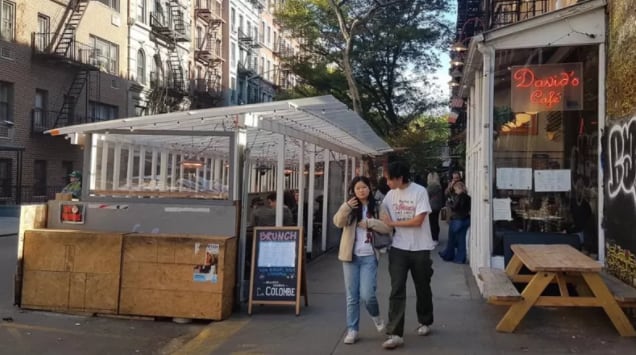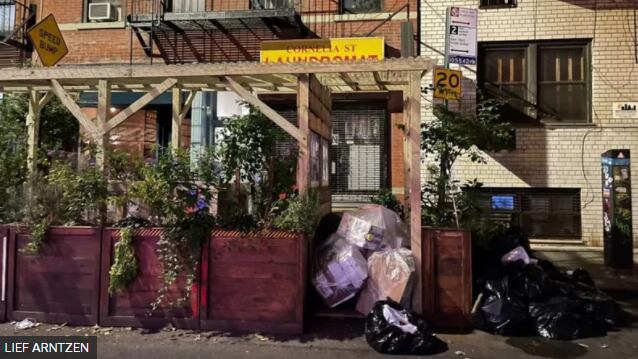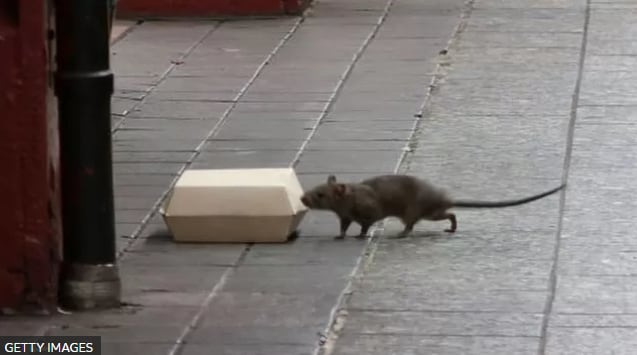Diem Boyd was sitting outside a restaurant in the Greenwich Village neighborhood of New York in September, when a herd of rats ran hastily between his feet.
“In a few seconds we all jumped”, dice. “We lost our appetite.”
- For the first time, a woman will lead the NYPD
- New York builds a wall to protect itself from floods
- The Supreme Court refuses to block the mandate to vaccinate toilets in New York
Everyone in New York has a similar story to tell, he explains. “We are going through a complete and total explosion of rats.”
“You see them when you go out at night”, agrees Deborah González, who, like Diem, lives in the southeastern part of Manhattan. “When you walk down this block, you see them running from one side to the other.”
It is difficult to calculate the precise figures, but calls to the New York City complaint line mentioning rodents have increased markedly this year: they are 15% above pre-pandemic levels.
“It’s obvious that New York has always had rats,” notes Marcell Rocha, who also lives in the neighborhood, but now “They are bigger and bolder, and they jump in front of you. They are gymnasts, they do cartwheels ”.
So what has changed?
Diem, Deborah and Marcell put the blame for this new plague squarely on the alfresco dining craze that became popular in the city during the pandemic, urging far more people to eat at outside tables.
Hundreds of streets in New York are lined -on both sides- with booths built for that use, completely changing the look of the urban landscape. HThere are more than 11,000 new cookouts.
Some of these places have little more than one frame and a few seats, others have more solid structures with floors, lanterns, flower pots and electric heaters.
Diem, Deborah and Marcell state that booths generate “mile-long” piles of black plastic garbage bags that pile up on sidewalks and provide the perfect den for rats under your floorboards.
However, these places have become immensely popular with the clientele in the last year and a half. In fact too popular with the locals.
“This is hell with crowds and noise,” complains Marcell. The Southeast sector has always been a lively neighborhood, but this past summer it felt like “living in a festival,” she explained.
At the beginning of the pandemic, New York Mayor Bill de Blasio launched the program “Open Restaurants”. It was part of a larger vision of a city less dominated by automotive traffic and more focused on residents and visitors. But most of all, it was a lifesaver for the hotel and restaurant industry.
And while the initial permit to set up outdoor dining areas was a temporary emergency measure, in late 2020, when indoor service began to resume, the mayor announced that wanted to make cookout a broad and permanent model.
“Open Restaurants was a big and bold experiment in support of a vital industry and the redesign of our public space, and it worked,” stated Bill de Blasio.
“As we enter a long-term recovery, we are proud to extend and expand this effort to keep New York the most vibrant city in the world.”
The City Council – the elected body that administers New York affairs – is currently in the process of debating and voting to withdraw urban land management regulations that limit cookouts.
That move has Diem, Marcell and Deborah on fire. They argue that no proper evaluation of the impact of restaurant booths has been carried out. They and another group of more than a dozen residents have filed a lawsuit to try to force the city to take a closer look at the effect that a permanent expansion of outdoor dining and socializing will have.
“That wasn’t the plan,” Deborah argues. He adds that when the emergency program was launched, residents backed it, in order to support the struggling hospitality and restaurant sector. But now they feel like their opinions are being ignored.
Say what rats, crowds, vomiting, and grime are very annoyingBut they are also concerned about the problem of older residents trying to navigate congested sidewalks.
Fire trucks have to slow to a snail’s pace on streets that have restaurant booths, he says. Other people have made similar complaints, and in May the New York City Fire Department tweeted that booths had delayed them from reaching the scene of a fire at a Chinese restaurant in downtown Manhattan.
From Chinatown to Queens, from Brooklyn to Greenwich Village, residents are demanding a reevaluation of the impact of cookout.
Some say it is altering the fundamental character of neighborhoods that weren’t once dominated by noisy nightlife. In other areas existing problems are being exacerbated.
As the weather has grown colder, the sheds have been covered in plastic sheeting, ending the original health and safety purpose in a well-ventilated space. Now you can see graffiti written on the booths, some of which are no longer in use and are falling into disrepair.
“It’s like a favela”Diem notes.
But not everyone sees it that way.
Jacob Siwak, head chef and owner of the Italian restaurant Forsythia, across from where Deborah lives, finds the criticism of the cookout program infuriating.
“I find it crazy that people are focusing on these minutiae, which can be slightly negative, when there are so many radically positive aspects”, He maintains.
Siwak says he is confident that his restaurant has added value to the entire block. “And it allows me to employ more people. I have a lot of staff that I can pay an adequate salary to live in New York. “
There are rules about how much you can occupy the street to put your booth, he points out, the equivalent of the width of a parked car. So he thinks that complaints about emergency vehicles having difficulty passing are “invalid.”
He acknowledges that New York has a problem with garbage collection, but ensures that food stands are not the culprit. And your restaurant isn’t making the situation worse. “We use ceramic plates, linen napkins and metal cutlery. We are not accumulating garbage, ”he says.
Andrew Rigie, Executive Director of the New York Hotel Alliance says that Making the cookout program permanent could be the catalyst the city needs to tackle the long-standing garbage problem.
New Yorkers leave most of their streetside trash in black plastic bags for collection by public or private firms – depending on whether it is household or commercial trash – a system that has been disrupted by the pandemic and booths. .
Riggie agrees that the system needs improvement, but says that shouldn’t get in the way of cookout.
“The current reality is that restaurants and the public enjoy dining al fresco. There is a demand to make it permanent ”.
But the current temporary program – established during the height of the crisis – will not become permanent. However, a new list of standards and regulations is being forged to address residents’ concerns, including grooming practices, nighttime noise, and activities that will be permitted.
“Will people have different opinions about whether or not they want different types of street activity? Of course. New York City is a large, complex place with many competing uses for public space, ”he says.
The city informed that the key principles of the program will be accessibility, appearance -including cleanliness and equality-, allowing the participation of all neighborhoods, ensuring that the set-ups of the restaurants work in the context and safety of the neighborhood, including access for emergency vehicles.
The Department of Transportation, which will oversee the permanent program, and the Department of Planning launched a consultation asking New Yorkers for input on how best to achieve those goals.
“The incredible success of the cookout shows how we can reimagine our urban environment to better serve our neighborhoods,” stated Department of Transportation Commissioner Hank Gutman.
Gutman says he will consult with the public to “develop guidelines” that will increase access and security and address issues such as noise, hours of operation and cleanliness.
But many residents remain deeply skeptical. They say the query will not reach many parts of the community, especially those who are not active on the internet. They maintain that the program has been poorly policed and think the same will happen with a new one.
Even if stricter conditions are agreed and controlled, they are suspicious of the forces at work behind the scenes.
“This is no longer about recovery,” says Diem. “Doubling the capacity of the restaurants allowing them the free use of the streets, means that the owners they are being awarded the largest expropriation of public land in the history of New York City”.
They will be able to raise rents and, as a result, favor bars and restaurants over small businesses, he argues, further undermining the character of many neighborhoods.
“Basically, that is our argument, apart from the fact that it is a public health danger, at all levels,” emphasizes Diem. “This is for the benefit of developers and homeowners at the expense of ordinary New Yorkers.”
- Next pandemic could be “worse or deadlier,” warns Oxford / AstraZeneca vaccine creator
- How the new Super Green Pass complicates social life for the unvaccinated in Italy
- Flight MH370: can one of the great mysteries of aviation finally be solved?
- Plumber finds money hidden in the wall of a megachurch (and could have solved a mysterious robbery from 2014)
- They find dead a young Brazilian who was missing and was forced to dig her own grave
- US Congressman Releases Christmas Family Photo With Guns, Days After School Shooting
.

:quality(75)/cloudfront-us-east-1.images.arcpublishing.com/elcomercio/PNE5H3GXVVBCTFD2GNKDIIRG7I.jpg)











